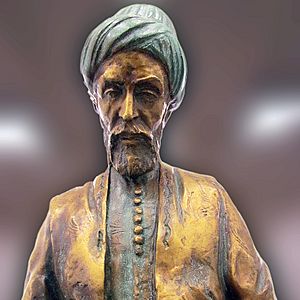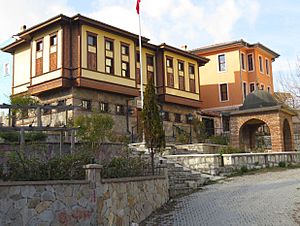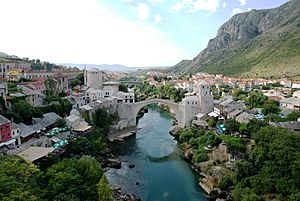Evliya Çelebi facts for kids
Quick facts for kids
Evliya Çelebi
|
|
|---|---|
 |
|
| Born |
Derviş Mehmed Zillî
25 March 1611 Constantinople, Ottoman Empire
|
| Died | 1682 (aged 70–71) |
| Other names | Tchelebi in French Tchalabi/Chalabi in English |
| Known for | Seyâhatnâme ("The Travelogue") |
Derviş Mehmed Zillî (born March 25, 1611 – died 1682), better known as Evliya Çelebi, was a famous Ottoman explorer. He traveled across the Ottoman Empire and nearby countries for about 40 years. He wrote down everything he saw and experienced in a huge travel book called the Seyâhatnâme ("Book of Travel").
The name Çelebi was an important title back then. It meant "gentleman" or "man of God."
Contents
Life of a Traveler

Evliya Çelebi was born in Constantinople in 1611. His family was wealthy and from Kütahya. Both his parents worked for the Ottoman court, which was like the royal palace. His father was a jeweler, and his mother was related to a very important official called the grand vizier.
Evliya Çelebi learned many things at the court. He was taught by the Imperial ulama, who were important scholars. He was a very religious Muslim and could even recite the Quran from memory. He also loved music and learned to play instruments and sing.
He started writing his journal in Constantinople, noting down details about buildings, markets, and local customs. In 1640, he began traveling outside the city. His notes grew into a ten-volume work called the Seyahatname. This book is special because he wrote it in a mix of everyday language and formal Turkish. This made it easy for many people to read and learn about life in the Ottoman Empire in the 1600s.
Evliya Çelebi passed away in 1682. It's not clear if he was in Istanbul or Cairo at that time.
Amazing Journeys
Exploring Croatia
Evliya Çelebi visited many parts of modern-day Croatia. He traveled through northern Dalmatia, parts of Slavonia, Međimurje, and Banija. He wrote down many historical and cultural details. Some of his stories were from his own experiences, some were told to him, and some he even made up!
Mostar's Famous Bridge

Evliya Çelebi visited the town of Mostar in what is now Ottoman Bosnia and Herzegovina. He wrote that the name Mostar means "bridge-keeper." This is because of the town's amazing bridge, the Old Bridge. It was 28 meters long and 20 meters high.
Çelebi described it beautifully: "It is like a rainbow arch soaring up to the skies, extending from one cliff to the other. ...I, a poor and miserable slave of Allah, have passed through 16 countries, but I have never seen such a high bridge. It is thrown from rock to rock as high as the sky."
Travels in Kosovo
In 1660, Çelebi went to Kosovo. He noted that in Vučitrn, people spoke Albanian or Turkish, and only a few spoke Serbian. He called the mountains around Tetovo, Peć, and Prizren the "mountains of Arnavudluk," which means Albania.
Visiting Albania
Çelebi traveled to Albania three times in 1670. He visited cities like Gjirokastra, Berat, Vlorë, Durrës, Ohër, Përmet, Skrapar, and Tepelenë. He wrote many interesting things about these places.
Europe and Beyond
Çelebi even claimed to have met Native Americans in Rotterdam during his visit in 1663. He wrote that they complained about greedy people causing wars.
While visiting Vienna in 1665–66, Çelebi noticed that some words in German and Persian sounded similar. This was an early observation about how languages can be related. He also visited Crete and described important events there, like the fall of Chania.
Oil in Azerbaijan
In Baku, Çelebi saw how oil was collected. He wrote: "By Allah's decree oil bubbles up out of the ground... Merchants wade into these pools and collect the oil in ladles and fill goatskins with it. These oil merchants then sell them in different regions."
Crimean Khanate and Slavery
Evliya Çelebi saw the impact of Cossack raids on the Crimean Khanate. These raids destroyed trade routes and made many areas lose people. He also wrote about the slave trade in Crimea. He described how families were sadly separated and sold. He estimated there were many enslaved people there at the time.
The Parthenon's Beauty
In 1667, Çelebi was amazed by the Parthenon in Greece. He described it as "like some impregnable fortress not made by human agency." He even wrote a poem wishing that the Parthenon, which seemed like a work of heaven, would stand forever.
Syria and Palestine
Çelebi visited Palestine twice, in 1649 and 1670–71. He wrote one of the few detailed travel books from an Islamic point of view about these lands. He often referred to the region as "Palestine" or "Land of Palestine."
Circassia's Hospitality
Çelebi traveled to Circassia and described the people there in great detail. He was very impressed by their kindness and hospitality. He wrote that they had no temples or markets, but travelers were always welcome in their homes. He said they would do everything to help a guest, even if they were an enemy.
He also mentioned how difficult the Circassian language was to learn. He said, "I wrote and spoke very well in all one hundred and forty-seven languages, but I could not write this Circassian language, which is like a magpie shout."
The Seyâhatnâme
The Seyâhatnâme is Evliya Çelebi's huge travel book. Even though some parts might be exaggerated or made up, his notes are still very helpful. They give us a great look into the culture and daily life of the Ottoman Empire in the 17th century. The first volume is all about Istanbul, and the last volume is about Egypt.
Today, there isn't a full English translation of the entire Seyahatname. However, parts of it have been translated. One of the longest English translations was done in 1834. More recent translations include a German version of the tenth volume and selections translated by Robert Dankoff and Sooyong Kim.
Evliya Çelebi was also known for collecting examples of the languages he heard during his travels. His book includes about 30 different Turkic languages and dialects. He even noticed similarities between German and Persian words. The Seyâhatnâme also has the first written examples of many languages of the Caucasus and Tsakonian.
Here are some of the journeys he described in his 10 volumes:
- Constantinople and nearby areas (1630)
- Anatolia, the Caucasus, Crete, and Azerbaijan (1640)
- Syria, Palestine, Armenia, and Rumelia (1648)
- Kurdistan, Iraq, and Iran (1655)
- Russia and the Balkans (1656)
- Military trips in Hungary during a war (1663/64)
- Austria, the Crimea, and the Caucasus again (1664)
- Greece, then the Crimea and Rumelia again (1667–1670)
- The Hajj (pilgrimage) to Mecca (1671)
- Egypt and the Sudan (1672)
Images for kids
-
Evlija Čelebija (Evliya Çelebi) street in modern Skopje.
See also
 In Spanish: Evliya Çelebi para niños
In Spanish: Evliya Çelebi para niños


